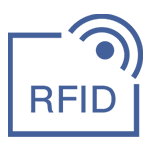NRF52833 RF Transceiver Bluetooth 2.4GHz 73-VFQ: Datasheet, Pinout, and nRf52833 vs nRF52840
TxRx + MCU 2.4GHz 1.7V~5.5V ADC, I2S, PWM, SPI, UART, USB 2Mbps 5.96mA - Receiving 16.1mA - Transmitting 512kB Flash 128kB RAM 42 73-VFQFN Dual Rows, Exposed Pad









TxRx + MCU 2.4GHz 1.7V~5.5V ADC, I2S, PWM, SPI, UART, USB 2Mbps 5.96mA - Receiving 16.1mA - Transmitting 512kB Flash 128kB RAM 42 73-VFQFN Dual Rows, Exposed Pad
The nRF52833 is a low-power multiprotocol SoC with a Bluetooth 5.1 Direction Finding radio that can operate in a wide temperature range of -40°C to 105°C. This article is going to introduce applications, features, and more details about NRF52833.
Overview of NRF52833
The nRF52833 is a low-power multiprotocol SoC with a Bluetooth 5.1 Direction Finding radio that can operate in a wide temperature range of -40°C to 105°C. It supports Bluetooth 5.1, Bluetooth mesh, 802.15.4, Thread, Zigbee, and proprietary 2.4 GHz protocols, as well as 802.15.4, Thread, Zigbee, and proprietary 2.4 GHz protocols.
The nRF52833 is the fifth member of the nRF52 Series SoC family, and it is based on a 64 MHz Arm Cortex-M4 with FPU, with 512 KB flash and 128 KB RAM memory for higher-value applications. The nRF52833 is a suitable device for a wide range of commercial and industrial applications, including professional lighting and asset monitoring, thanks to its expanded temperature range up to 105°C, a significant quantity of memory, and dynamic multiprotocol compatibility. A 1:4 RAM to Flash ratio and +8 dBm output power make the nRF52833 suitable for advanced wearables or smart home applications where robust coverage is important.
NRF52833 Features
64 MHz Arm® Cortex-M4 with FPU
512 KB Flash + 128 KB RAM
Bluetooth 5.1 radio
--Direction Finding
--Long Range
--Bluetooth mesh
--+8 dBm TX power
---95 dBm sensitivity (1 Mbps)
--4.8 mA in TX (0 dBm)
--4.6 mA in RX (1 Mbps)
--Integrated balun with single-ended output
IEEE 802.15.4 radio support
--Thread
--Zigbee
Extended temperature range: -40°C to 105°C
1.7-5.5 V supply voltage range
Integrated DC-DC regulator
Full-speed 12 Mbps USB
NFC-A tag
128 bit AES/ECB/CCM/AAR accelerator
12-bit 200 ksps ADC
High speed 32 MHz SPI
Full range of digital interfaces with EasyDMA
NRF52833 Pinout
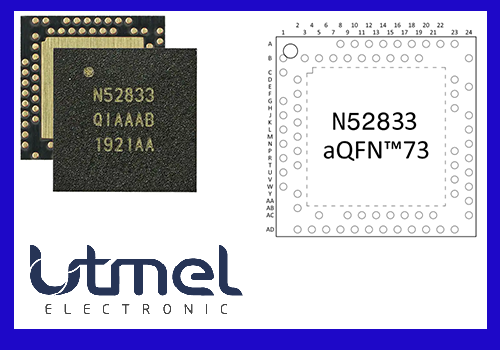
NRF52833 Pinout
NRF52833 Block Diagram

NRF52833 Block Diagram
Specifications
- TypeParameter
- Mounting Type
The "Mounting Type" in electronic components refers to the method used to attach or connect a component to a circuit board or other substrate, such as through-hole, surface-mount, or panel mount.
Surface Mount - Package / Case
refers to the protective housing that encases an electronic component, providing mechanical support, electrical connections, and thermal management.
73-VFQFN Dual Rows, Exposed Pad - Operating Temperature
The operating temperature is the range of ambient temperature within which a power supply, or any other electrical equipment, operate in. This ranges from a minimum operating temperature, to a peak or maximum operating temperature, outside which, the power supply may fail.
-40°C~105°C - Packaging
Semiconductor package is a carrier / shell used to contain and cover one or more semiconductor components or integrated circuits. The material of the shell can be metal, plastic, glass or ceramic.
Tape & Reel (TR) - Part Status
Parts can have many statuses as they progress through the configuration, analysis, review, and approval stages.
Active - Moisture Sensitivity Level (MSL)
Moisture Sensitivity Level (MSL) is a standardized rating that indicates the susceptibility of electronic components, particularly semiconductors, to moisture-induced damage during storage and the soldering process, defining the allowable exposure time to ambient conditions before they require special handling or baking to prevent failures
3 (168 Hours) - TypeTxRx + MCU
- Voltage - Supply
Voltage - Supply refers to the range of voltage levels that an electronic component or circuit is designed to operate with. It indicates the minimum and maximum supply voltage that can be applied for the device to function properly. Providing supply voltages outside this range can lead to malfunction, damage, or reduced performance. This parameter is critical for ensuring compatibility between different components in a circuit.
1.7V~5.5V - Frequency
In electronic components, the parameter "Frequency" refers to the rate at which a signal oscillates or cycles within a given period of time. It is typically measured in Hertz (Hz) and represents how many times a signal completes a full cycle in one second. Frequency is a crucial aspect in electronic components as it determines the behavior and performance of various devices such as oscillators, filters, and communication systems. Understanding the frequency characteristics of components is essential for designing and analyzing electronic circuits to ensure proper functionality and compatibility with other components in a system.
2.4GHz - Memory Size
The memory capacity is the amount of data a device can store at any given time in its memory.
512kB Flash 128kB RAM - Protocol
In electronic components, the parameter "Protocol" refers to a set of rules and standards that govern the communication between devices. It defines the format, timing, sequencing, and error checking methods for data exchange between different components or systems. Protocols ensure that devices can understand and interpret data correctly, enabling them to communicate effectively with each other. Common examples of protocols in electronics include USB, Ethernet, SPI, I2C, and Bluetooth, each with its own specifications for data transmission. Understanding and adhering to protocols is essential for ensuring compatibility and reliable communication between electronic devices.
Bluetooth v5.1, Thread, Zigbee® - Power - Output
Power Output in electronic components refers to the amount of electrical power that a device can deliver to a load. It is typically measured in watts and indicates the effectiveness of the component in converting electrical energy into usable work or signal. Power Output can vary based on the component's design, operating conditions, and intended application, making it a critical factor in the performance of amplifiers, power supplies, and other electronic devices. Understanding the Power Output helps in selecting appropriate components for specific applications to ensure efficiency and reliability.
8dBm - Sensitivity
Sensitivity in electronic components refers to the degree to which the output of a device responds to changes in input. It indicates how effectively a component translates a specific input signal into an observable output. High sensitivity means that even small variations in input can produce significant changes in output, making the device more responsive to signals. Sensitivity is crucial in applications where precise measurements or signal detection are required.
-103dBm - Data Rate (Max)
Data Rate (Max) refers to the maximum rate at which data can be transferred or processed within an electronic component or device. It is typically measured in bits per second (bps) or megabits per second (Mbps). This parameter is important for determining the speed and efficiency of data transmission or processing in various electronic applications such as computer systems, networking devices, and memory modules. A higher data rate indicates that the component is capable of handling larger volumes of data at a faster pace, leading to improved performance and responsiveness in electronic systems. It is crucial to consider the Data Rate (Max) specification when selecting electronic components to ensure compatibility and optimal functionality for specific applications.
2Mbps - Serial Interfaces
A serial interface is a communication interface between two digital systems that transmits data as a series of voltage pulses down a wire. Essentially, the serial interface encodes the bits of a binary number by their "temporal" location on a wire rather than their "spatial" location within a set of wires.
ADC, I2S, PWM, SPI, UART, USB - Current - Receiving
Current - Receiving refers to the amount of electrical current that an electronic component or device is capable of accepting from a power source or another component in a circuit. It indicates the maximum current that can be safely received without causing damage or malfunction. This parameter is crucial for ensuring compatibility and reliability in electronic designs, as exceeding the rated receiving current can lead to overheating or failure of the component.
5.96mA - Current - Transmitting
Current - Transmitting is a parameter used to describe the maximum amount of electrical current that an electronic component can handle while in the transmitting mode. This parameter is crucial for components such as transistors, diodes, and integrated circuits that are involved in transmitting signals or power within a circuit. Exceeding the specified current transmitting rating can lead to overheating, component failure, or even damage to the entire circuit. Designers and engineers must carefully consider this parameter when selecting components to ensure the reliability and performance of the electronic system.
16.1mA - GPIO
GPIO stands for General Purpose Input/Output. It is a type of electronic pin found on microcontrollers, microprocessors, and other integrated circuits that can be configured to either input or output digital signals. GPIO pins can be used to connect and communicate with external devices such as sensors, LEDs, motors, and more. They provide a flexible way to interact with the physical world by allowing the device to both receive and send digital signals. GPIO pins can be programmed and controlled by software to perform various functions based on the specific requirements of the electronic system.
42
NRF52833 Supported Features
| Interface | Controller | Driver/Component |
| ADC | on-chip | adc |
| CLOCK | on-chip | clock_control |
| FLASH | on-chip | flash |
| GPIO | on-chip | gpio |
| I2C(M) | on-chip | i2c |
| MPU | on-chip | arch/arm |
| NVIC | on-chip | arch/arm |
| PWM | on-chip | pwm |
| RADIO | on-chip | Bluetooth,ieee802154 |
| RTC | on-chip | system clock |
| RTT | Segger | console |
| SPI(M/S) | on-chip | spi |
| UART | on-chip | serial |
| USB | on-chip | usb |
| WDT | on-chip | watchdog |
NRF52833 Absolute maximum ratings

NRF52833 Absolute maximum ratings
NRF52833 Bluetooth Direction Finding
A radio capable of Bluetooth® Direction Finding is included in the nRF52833. With Direction Finding, positioning solutions can rely on not just the received signal strength indicator (RSSI), but also the signal's true direction. This enhances precision and expands the range of applications available in this market. The angle of arrival (AoA), which calculates the direction of the received signal, and angle of departure (AoD), which calculates the direction of the transmitted signal, are the two sorts of methods for detecting direction.
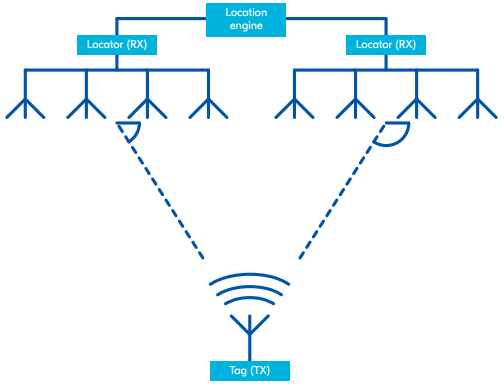
NRF52833 Applications
Professional lighting
Asset tracking
Wayfinding
Multiprotocol devices
Mesh networks
Advanced wearables
Smart home
HID/Gaming/VR
Toys
Sports and fitness
NRF52 Series
| Descriptions | Manufacturer Part Number | Datasheet | Images | |
| NRF52833-DK | RF Evaluation and Development Kits, Boards EVAL KIT FOR NRF52833 SOC | Nordic Semiconductor ASA | NRF52833-DK Datasheet |  |
| NRF52833-QIAA-R | RF Transceiver ICs IC RF TxRx + MCU Bluetooth v5.1, Thread, Zigbee? 2.4GHz 73-VFQFN Dual Rows, Exposed Pad | Nordic Semiconductor ASA | NRF52833-QIAA-R Datasheet | 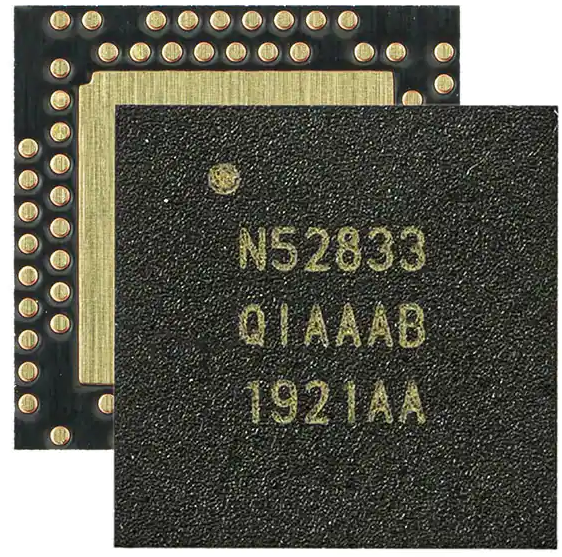 |
nRf52833 vs nRF52840
| nRf52833 | nRF52840 | |
| Operating Temperature | -40°C~105°C | -40°C~85°C |
| Protocol | Bluetooth v5.1, Thread, Zigbee® | Bluetooth v5.0 |
| Sensitivity | -103dBm | -96dBm |
| Serial Interfaces | ADC, I2S, PWM, SPI, UART, USB | I2C, I2S, SPI, UART, USB |
| Current - Transmitting | 16.1mA | 16.4mA |
| Memory Size | 512kB Flash 128kB RAM | 1MB Flash 256kB RAM |
| Current - Receiving | 5.96mA | 6.3mA |
| GPIO | 42 | 48 |
| Images |  |  |
| Datasheet | nRf52833 Datasheet | nRF52840 Datasheet |
nRf52833 Manufacturer
Nordic Semiconductor is a fabless semiconductor company specializing in short-range wireless and low-power cellular IoT. Nordic pioneered ultra-low-power wireless and helped develop Bluetooth Low Energy, a widely-adopted wireless technology. The company’s award-winning Bluetooth LE solutions have made it the market leader, and are complemented by ANT+, Thread, and Zigbee products. Nordic’s reputation is built on the supply of leading-edge wireless technologies and development tools that shield designers from RF complexity. This approach extends to Nordic’s latest technology, cellular IoT. Launched in 2018 after four years of development, this NB-IoT and LTE-M solution leverages cellular infrastructure to extend the IoT.
Popularity by Region
Datasheet PDF
- Datasheets :
- PCN Design/Specification :
- PCN Packaging :
What is the nRf52833?
The nRF52833 is a general-purpose multiprotocol SoC with a Bluetooth Direction Finding radio that can operate at temperatures ranging from -40 to 105 degrees Celsius.
What is DK board?
On the nRF52805, nRF52810, and nRF52832 SoCs, the nRF52 DK is a versatile single-board development kit for Bluetooth Low Energy, Bluetooth mesh, NFC, ANT, and 2.4 GHz proprietary development. It makes it easier to design applications that take advantage of all of the characteristics of the nRF52805, nRF52810, and nRF52832 SoCs.
What is a nRF52840?
The nRF52840 is a 2.4 GHz wireless system on chip (SoC) that includes a multiprotocol 2.4 GHz transceiver, an Arm® Cortex®-M4F processor, and flash program memory. It's the ideal SoC for any IPv6-enabled automation or short-range wireless personal area network application.
How do I program my nRF52840?
Open nRF Connect for Desktop and launch nRF Connect Programmer. Insert the nRF52840 Dongle into a USB port on the computer. Put the dongle into bootloader mode by pressing the RESET button.
What are the operating temperature of nRf52833 and nRF52840 respectively?
The operating temperature of nRf52833 is -40°C~105°C, while the operating temperature of nRF52840 is -40°C~85°C.
![282080-1 Rectangular Connectors Housings CONN PLUG BLACK[Video]: Datasheet, Features, and Drawings](https://res.utmel.com/Images/Article/61199823-de3e-4a6f-a253-0628aba362d6.jpg) 282080-1 Rectangular Connectors Housings CONN PLUG BLACK[Video]: Datasheet, Features, and Drawings
282080-1 Rectangular Connectors Housings CONN PLUG BLACK[Video]: Datasheet, Features, and Drawings29 March 20222436
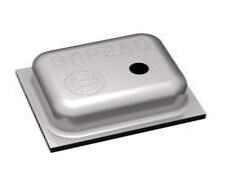 BMP280 Sensor: Pinout, Application, Circuit and Comparison
BMP280 Sensor: Pinout, Application, Circuit and Comparison18 August 20214411
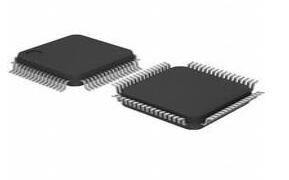 AS1120 LCD Driver: Datasheet, Pinout, Application
AS1120 LCD Driver: Datasheet, Pinout, Application06 September 2021324
 STM32F103CBT6 - STM - Microcontroller
STM32F103CBT6 - STM - Microcontroller29 April 20215710
 LPC1769 Microcontroller: Pinout, Datasheet and Programming
LPC1769 Microcontroller: Pinout, Datasheet and Programming23 September 20216015
 DS18S20 Temperature Sensor: Datasheet, Pinout and Comparison
DS18S20 Temperature Sensor: Datasheet, Pinout and Comparison01 November 20212419
 E91 Energizer AA Alkaline Battery: E91 vs Lithium Batteries, Datasheet, Features
E91 Energizer AA Alkaline Battery: E91 vs Lithium Batteries, Datasheet, Features18 January 20229890
 43025-0800 Micro-Fit 3.0 Receptacle Housing Dual Row: Drawing, Datasheet, and Equivalents
43025-0800 Micro-Fit 3.0 Receptacle Housing Dual Row: Drawing, Datasheet, and Equivalents11 February 20222050
 What is Metaverse?
What is Metaverse?09 October 20212657
 What is a variable capacitor?
What is a variable capacitor?16 April 202558665
 Introduction to BAW Filter
Introduction to BAW Filter25 September 20219352
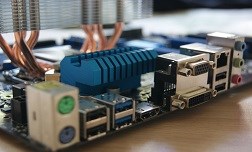 -5V, -3V, How is the Negative Voltage Generated? Attached Circuit Analysis and Scheme
-5V, -3V, How is the Negative Voltage Generated? Attached Circuit Analysis and Scheme13 September 20227578
 Is there a Limit to the Chip Process Node?
Is there a Limit to the Chip Process Node?02 November 202117345
 Review of IoT-Based Smart Home Security Systems- Part 1
Review of IoT-Based Smart Home Security Systems- Part 128 March 20243443
 The Ultimate Guide to AI Noise Reduction Translation Earbuds
The Ultimate Guide to AI Noise Reduction Translation Earbuds01 April 20253324
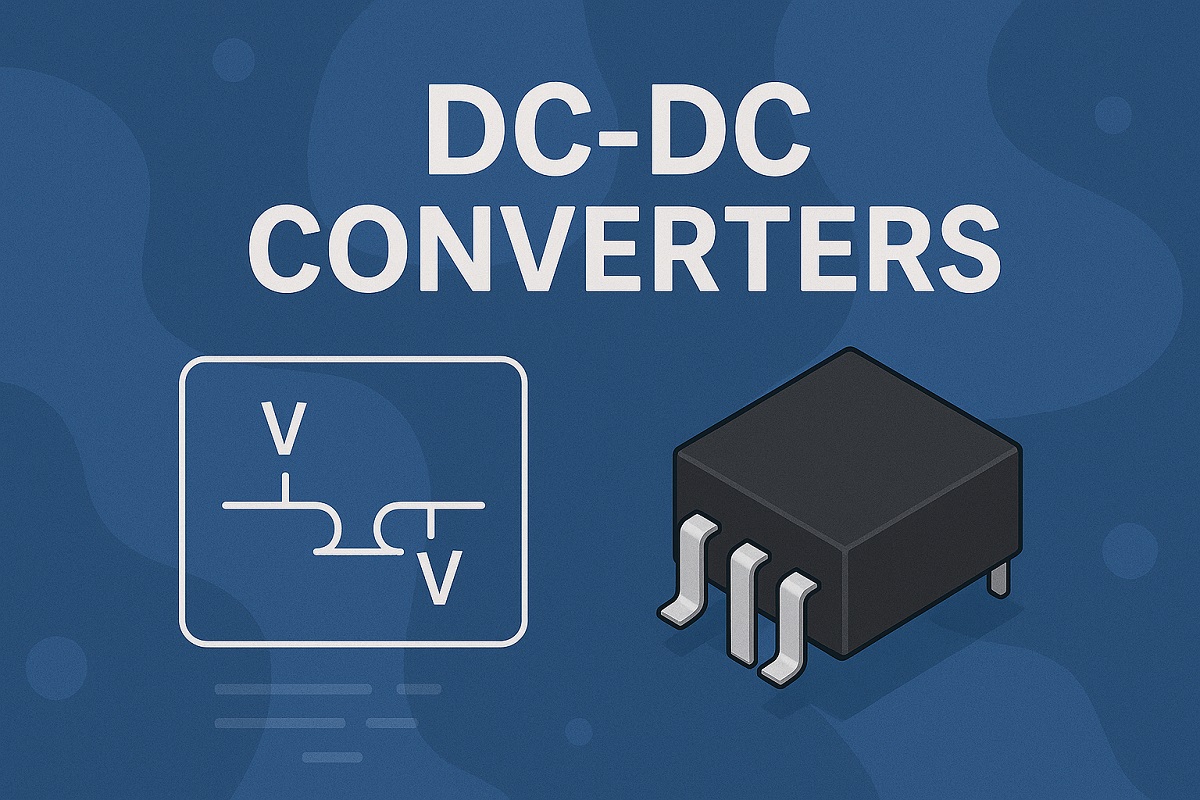 The Complete Guide to DC-DC Converters
The Complete Guide to DC-DC Converters24 May 2025954
Nordic Semiconductor ASA
In Stock: 11950
United States
China
Canada
Japan
Russia
Germany
United Kingdom
Singapore
Italy
Hong Kong(China)
Taiwan(China)
France
Korea
Mexico
Netherlands
Malaysia
Austria
Spain
Switzerland
Poland
Thailand
Vietnam
India
United Arab Emirates
Afghanistan
Åland Islands
Albania
Algeria
American Samoa
Andorra
Angola
Anguilla
Antigua & Barbuda
Argentina
Armenia
Aruba
Australia
Azerbaijan
Bahamas
Bahrain
Bangladesh
Barbados
Belarus
Belgium
Belize
Benin
Bermuda
Bhutan
Bolivia
Bonaire, Sint Eustatius and Saba
Bosnia & Herzegovina
Botswana
Brazil
British Indian Ocean Territory
British Virgin Islands
Brunei
Bulgaria
Burkina Faso
Burundi
Cabo Verde
Cambodia
Cameroon
Cayman Islands
Central African Republic
Chad
Chile
Christmas Island
Cocos (Keeling) Islands
Colombia
Comoros
Congo
Congo (DRC)
Cook Islands
Costa Rica
Côte d’Ivoire
Croatia
Cuba
Curaçao
Cyprus
Czechia
Denmark
Djibouti
Dominica
Dominican Republic
Ecuador
Egypt
El Salvador
Equatorial Guinea
Eritrea
Estonia
Eswatini
Ethiopia
Falkland Islands
Faroe Islands
Fiji
Finland
French Guiana
French Polynesia
Gabon
Gambia
Georgia
Ghana
Gibraltar
Greece
Greenland
Grenada
Guadeloupe
Guam
Guatemala
Guernsey
Guinea
Guinea-Bissau
Guyana
Haiti
Honduras
Hungary
Iceland
Indonesia
Iran
Iraq
Ireland
Isle of Man
Israel
Jamaica
Jersey
Jordan
Kazakhstan
Kenya
Kiribati
Kosovo
Kuwait
Kyrgyzstan
Laos
Latvia
Lebanon
Lesotho
Liberia
Libya
Liechtenstein
Lithuania
Luxembourg
Macao(China)
Madagascar
Malawi
Maldives
Mali
Malta
Marshall Islands
Martinique
Mauritania
Mauritius
Mayotte
Micronesia
Moldova
Monaco
Mongolia
Montenegro
Montserrat
Morocco
Mozambique
Myanmar
Namibia
Nauru
Nepal
New Caledonia
New Zealand
Nicaragua
Niger
Nigeria
Niue
Norfolk Island
North Korea
North Macedonia
Northern Mariana Islands
Norway
Oman
Pakistan
Palau
Palestinian Authority
Panama
Papua New Guinea
Paraguay
Peru
Philippines
Pitcairn Islands
Portugal
Puerto Rico
Qatar
Réunion
Romania
Rwanda
Samoa
San Marino
São Tomé & Príncipe
Saudi Arabia
Senegal
Serbia
Seychelles
Sierra Leone
Sint Maarten
Slovakia
Slovenia
Solomon Islands
Somalia
South Africa
South Sudan
Sri Lanka
St Helena, Ascension, Tristan da Cunha
St. Barthélemy
St. Kitts & Nevis
St. Lucia
St. Martin
St. Pierre & Miquelon
St. Vincent & Grenadines
Sudan
Suriname
Svalbard & Jan Mayen
Sweden
Syria
Tajikistan
Tanzania
Timor-Leste
Togo
Tokelau
Tonga
Trinidad & Tobago
Tunisia
Turkey
Turkmenistan
Turks & Caicos Islands
Tuvalu
U.S. Outlying Islands
U.S. Virgin Islands
Uganda
Ukraine
Uruguay
Uzbekistan
Vanuatu
Vatican City
Venezuela
Wallis & Futuna
Yemen
Zambia
Zimbabwe


